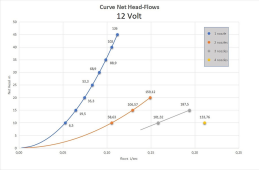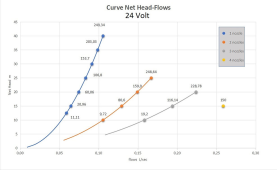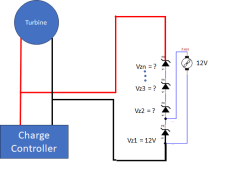FilterGuy
Solar Engineering Consultant - EG4 and Consumers
I am not sure how that would work. It would need to adjust the flow based on the battery SOC.Control the water flow (bypass/spill way if you must) instead of a dump load.
I am not sure how that would work. It would need to adjust the flow based on the battery SOC.Control the water flow (bypass/spill way if you must) instead of a dump load.
Just like a solar panel, a turbine has a maximum power point. You want to first find the maximum power point by adjusting the flow. As the flow increases, the power output increases but the water pressure decreases due to the flow through the weir. At some point, the pressure gets so low that the power starts decreasing.Generally speaking, a higher flow will result in lower pressure at the nozzle due to pipe loss in the Weir.
I am not sure how that would work. It would need to adjust the flow based on the battery SOC.
Seems overly complicated compared to a dump load with a pwm controller.PWM. Open a dump valve, or cut off water to turbine, when battery voltage hits target.
Diverter at nozzle could also do it. I understand large turbines deal with sudden load dump by turning nozzle away.
Small system, maybe open a solenoid valve to dump excess. Avoids water hammer compared to shutting off flow, but wastes water.
Can't do good linear control with a valve, that wastes power dropping pressure across valve.
Ideally would have an adjustable orifice nozzle, allowing water to back up in reservoir.
Maybe a needle motored into center of nozzle.
Multiple nozzles, turn each on/off to vary flow. Several diameters and it would be like a binary code.
Graphs give watts vs. flow rate. But say nothing about head.
Is it all on your property? Back up water onto someone's property? Run of river (down stream rights)?
BTW: Make sure you understand the water use rules in your location. There are horror stories of people putting systems on their own property and then the government dropping a huge fine on them for not having the right permits.It’s mostly all on my property. A spring that naturally flows, the rest comes from a little lake further above that’s fed by another spring that drains down on my property.
Pipe loss is real and should be accounted for. Of course, you can lower pipe loss with larger pipes, but it is just like wiring. At some point making it larger is just not worth the gain. Even if the pipe loss is zero, you need to find the right Pmax combination of pressure and flow. At some point, the additional flow will not create more power and it is just wasting water. In fact, if the turbine housing cant drain the excess water, it will cause turbulence and reduce the power output.Lost pressure due to higher flow had better not be significant. If it is, pipe is too small.
Pressure at the nozzle makes velocity, and turbine speed needs to drop water velocity near zero to extract all the energy.
Normally done by winding alternator for a given head and voltage. Controllable field winding would accomplish same, has efficiency loss compared to permanent magnet. Switcher (e.g. MPPT) could electronically match generation to battery voltage.
If you click on the picture, it’ll give head on the left. Attached is a pic


My impression from the description is that the catchment at the top of the weir is not going to be large. Consequently, anything that is not going into the penstock is going to go down the stream. (It will be 'wasted' anyway).It may be.
With limited water source, would like to use reservoir as battery, not waste it.
But the commodity lithium batteries are probably cost-competitive.
I see your point. It all comes down to how much you want to pay for the insurance.Unless open-circuit voltage is within BMS tolerance, I think you want redundant protection. I could imagine PWM dump load failing open.
Maybe over-voltage detection to remote trip breaker. Or to shorting relay, but that would likely cycle on and off. Bistable relay?
My impression from the description is that the catchment at the top of the weir is not going to be large. Consequently, anything that is not going into the penstock is going to go down the stream. (It will be 'wasted' anyway).

45 meters, 148’Both graphs go to only 45' head. Maybe it can handle the higher RPM of your 77', maybe not.
This is all in Central America. Anything goes. Only thing that could happen is the neighbor above block that overflow off of his little lakeMake sure you understand the water use rules in your location. There are horror stories of people putting systems on their own property and then the government dropping a huge fine on them for not having the right permits.
Yes, I’ve considered this several times. If this 248 watts is true with my setup, then there’s nothing else like it, American or Chinese made. I’m sure I could swap the plastic pelton for something more durable.I would expect plastic nozzles and wheel to be short lived compared to copper/brass/bronze.


